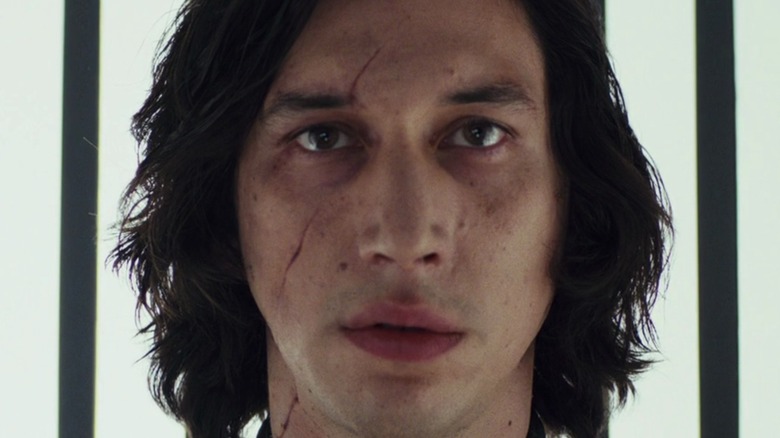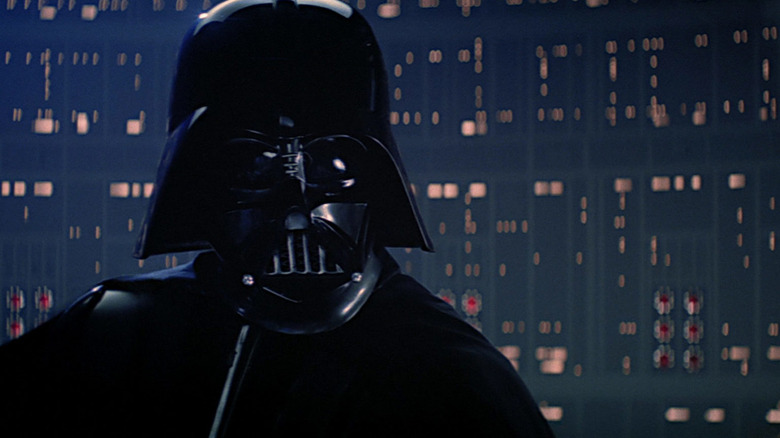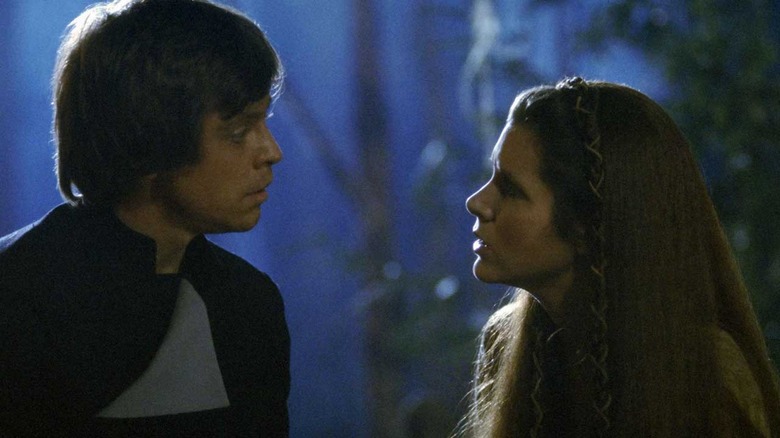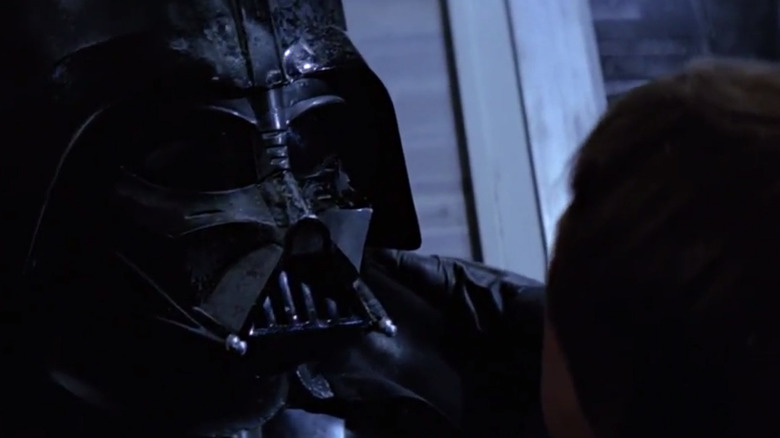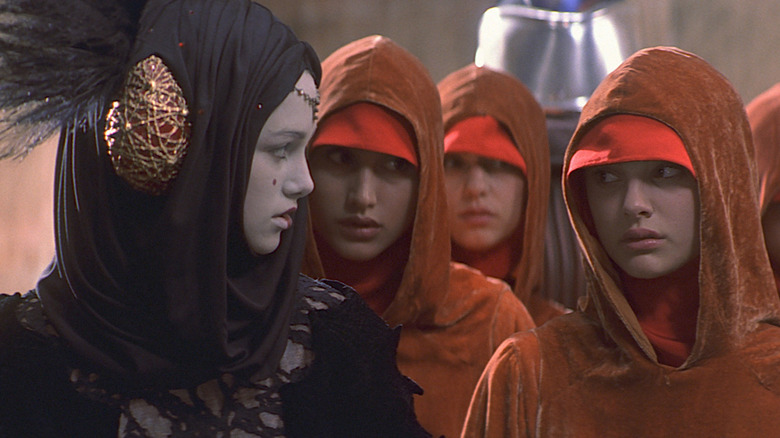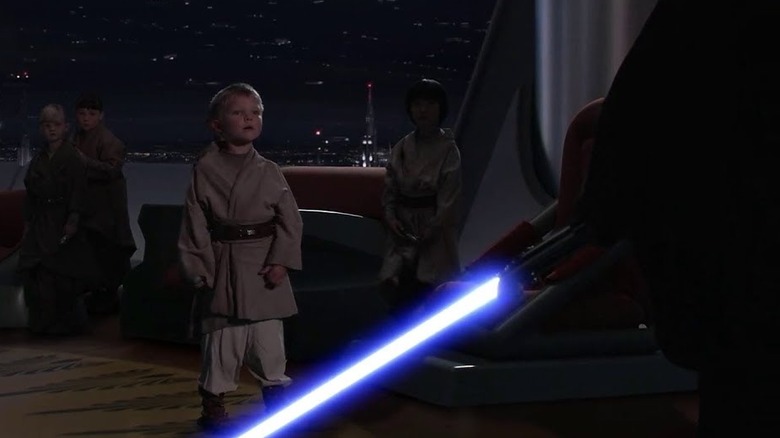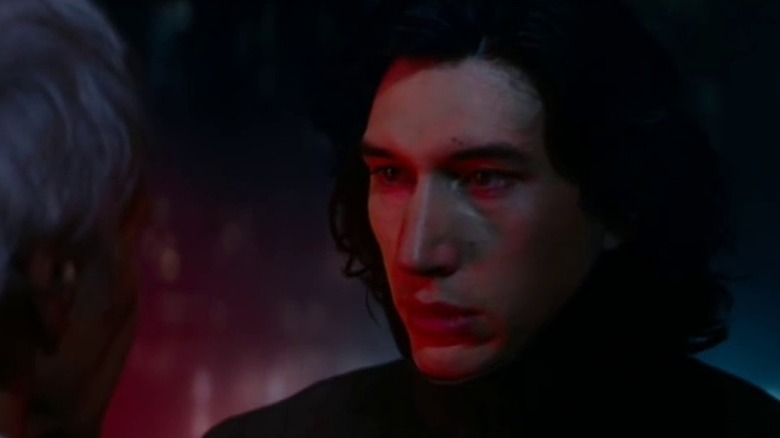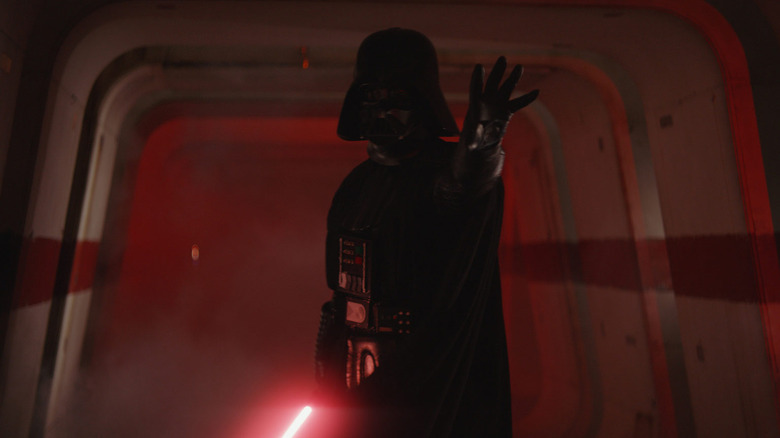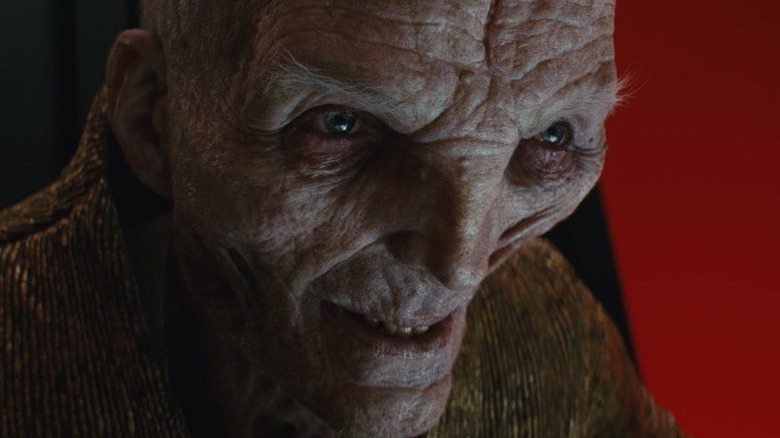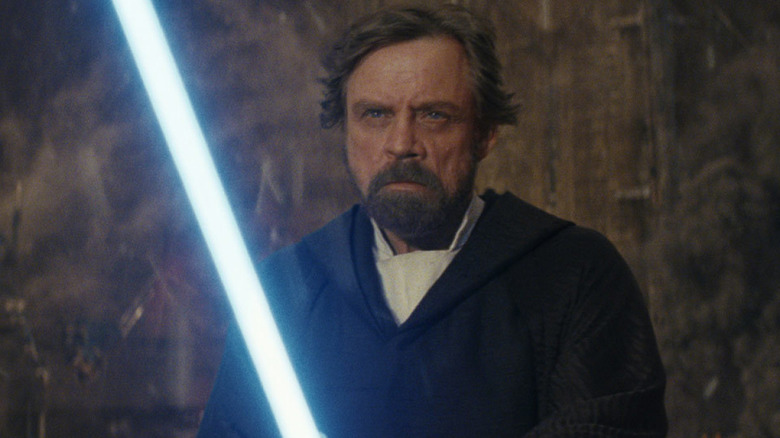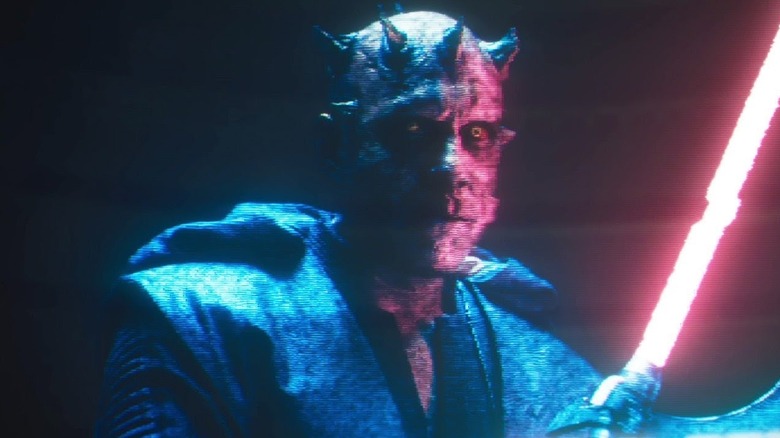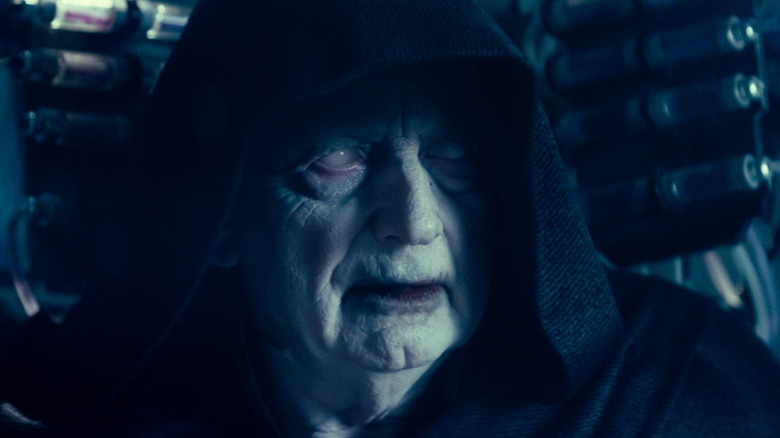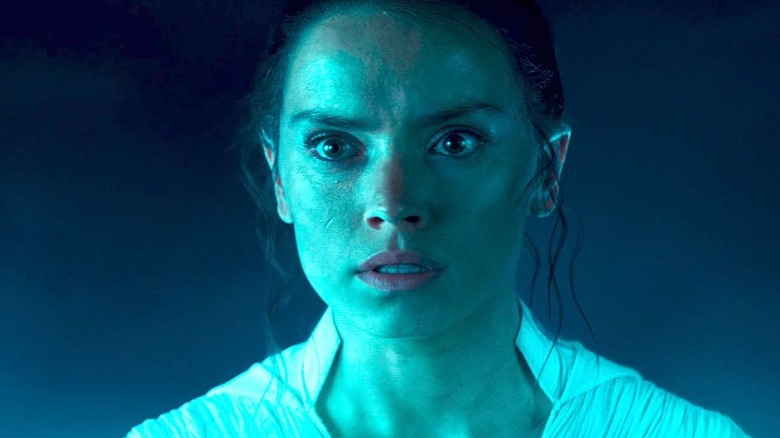The Most Unexpected Things To Happen In Star Wars
For more than 45 years, the "Star Wars" franchise has delighted fans of all ages and provided fans with countless memorable moments, and plenty of twists and turns. While the universe has subsequently expanded into several popular television series, the movies are where it all began and where we were introduced to a galaxy far, far away.
From "A New Hope" in 1977 to "The Rise Of Skywalker" in 2019, the "Star Wars" movies have constantly kept us guessing and coming back for more. There's been world-shattering revelations, surprise character appearances, and some controversial decisions along the way. While you're never certain exactly how things will turn out, you can be certain that it'll always be an enjoyable ride to get there.
Every "Star Wars" fan has their favorite moments in the series, and some of the ones most likely to stick with you are the ones that are truly unexpected. As a long-running saga, the films have to keep you on your toes, speculating and theorizing as to what might happen in the next installment. With plenty to choose from across the "Skywalker Saga" and the spin-off anthology movies, these are just some of the most unexpected "Star Wars" moments ... and be warned, major plot spoilers lie ahead.
Darth Vader is Luke's father
There's no better place to start when it comes to unexpected "Star Wars" moments than this shocking reveal from "The Empire Strikes Back." With social media these days, it is sometimes impossible to avoid spoilers for big releases. Thankfully, the audiences for this film didn't have Twitter to contend with. This means that legions of fans would've found out the film's shocking secret completely organically -– unless, of course, someone was cruel enough to spoil it by telling them beforehand.
With "A New Hope" already establishing our main protagonist and antagonist –- Luke Skywalker and Darth Vader, respectively -– the stage is set in "The Empire Strikes Back" for a continuation of this battle of good against evil. Having lost his former Master, Luke trains under Yoda, learning to use the Force and combat the negative emotions that might lead him to the dark side. While on Dagobah with Yoda, Luke experiences a disturbing vision, where he sees himself under Vader's helmet.
Even with this suggestion that there is something that connects Luke and Vader, the reveal that they are father and son is still completely out of the blue. Luke (and the audience) has been led to believe that Vader was the one responsible for killing his parents, which makes it even more surprising. A plot twist like this is also one that has huge repercussions for the characters and completely changes the films from this point — a defining moment for both "Star Wars" and cinema more broadly.
Luke and Leia are siblings
It's a slightly less shocking familial revelation than Vader being Luke's father, but the moment we find out Luke and Leia are related is also an unforgettable one. While it does make particular scenes prior to this a little uncomfortable on a rewatch -– let's not forget that they did share a kiss in "Empire Strikes Back" -– it is nonetheless still important.
In "Return Of The Jedi," Luke speaks with the ghost of Obi-Wan Kenobi who offers some explanation about why he kept Luke's parentage a secret from him. In answer to Luke's question about who Vader meant by "another," he speaks of a twin sister and Luke deduces that he is talking about Leia. Over the years, we have come to expect that a lot of people in the "Star Wars" universe are going to be related to each other — but at this time, it was still surprising to find out that two of our heroes were siblings.
Luke's revelatory moment about Vader is given much more weight, but it is worth remembering that when Luke tells Leia the truth, she is in the same situation. Luke may have more of a stake in this fight with Vader, but Leia is left to absorb that she is related to the person responsible for destroying her home planet –- making this battle personal for her as well.
Darth Vader's redemption
When Luke and Darth Vader fought in "The Empire Strikes Back," it was clear that Vader had the upper hand. However, when they fight in "Return Of The Jedi," Luke is physically stronger than before, and also armed with the knowledge that his father was once a good man — and therefore has the potential to change.
When they meet again, Luke tells Vader that he sees the conflict in him, and the potential for good. The two duel in what is one of the more meaningful battles of the series, as much an emotional fight as it is a physical one. With Luke poised to strike the final blow to Vader, the Emperor intervenes and tries to kill him. Just as it appears all hope is lost for Luke, Vader has a change of heart and kills the Emperor himself.
Throughout the films, Darth Vader has been positioned as a merciless villain, so at this late stage, it is shocking to see him suddenly switch. We may have expected to see the good guys beat the bad guys, but to see one of the worst ones receive some redemption is as satisfying as it is surprising.
The Padmé & Amidala Switch
In the first installment of the prequel trilogy, "The Phantom Menace," we're introduced to a host of new characters. One of these is Padmé Amidala, the young Queen of Naboo who later marries Anakin Skywalker and is the mother of Luke and Leia.
With the galaxy's Trade Federation blockading her planet in preparation for launching an invasion, Amidala attempts — with the help of Jedi Knights Qui-Gon Jinn and Obi-Wan Kenobi –to negotiate with the corrupt senate on Coruscant. As a high-profile figure, Amidala's life is frequently at risk, and in order to protect herself, she frequently enlists one of her loyal handmaidens to act as a decoy for her, posing as a handmaiden instead using her birth name of Padmé.
Keeping this secret from even Qui-Gon and Obi-Wan, the truth is eventually revealed when they form an alliance with the Gungans in their fight against the Federation. The moment the real Padmé Amidala steps out from behind the Queen was as much a surprise to audiences as it was to the other characters. In the film, the convincing decoy was played by Keira Knightley, and according to Star Wars' official website, even their own mothers couldn't tell them apart when they were in the make-up as they looked so similar.
Anakin kills the younglings
While we know the road that Anakin Skywalker eventually takes to become the evil Darth Vader, the things he does along the way are still surprising. We see Anakin gradually being seduced by the dark side, but when he callously murders the young Jedi in training, we realize there is no turning back.
In "Revenge Of The Sith," Anakin is afflicted by terrifying visions of Padmé dying in childbirth. As he becomes closer to Palpatine, he is lured with the promise that he can prevent death by joining the dark side. When Anakin pledges allegiance to the Sith, he is renamed Darth Vader, and Palpatine issues Order 66 -– commanding clone troopers to kill the Jedi.
Palpatine says to Anakin, "Every single Jedi, including your friend Obi-Wan Kenobi, is now an enemy of the Republic. Do not hesitate. Show no mercy. Only then will you be strong enough with the Dark Side to save Padmé." Drunk on power and driven by his desire to save Padmé, Anakin takes this instruction to heart, even killing the children who were being trained as Jedi. Even though it happens off-screen, it was one of the most unexpected moments in the saga and an indication of the true evil that Anakin is capable of.
Kylo Ren kills Han Solo
When the sequel trilogy was announced, the excitement at seeing Princess Leia, Luke Skywalker, and Han Solo on the screen once again was palpable. Ten years had passed between the release of "Revenge Of The Sith" and "The Force Awakens," but it had been more than 30 years since we had seen the characters from the original trilogy.
"Star Wars" notoriously likes to keep things in the family and when we were introduced to the new villain, Kylo Ren, we also quickly learned that he was the son of Leia and Han. Kylo Ren –- who his parents had named Ben -– was inspired by the legacy of his grandfather and joined the dark side. Leia remains convinced that Han can bring Ben back into the light, setting the stage for their dramatic confrontation.
Han calls out to his son, and Ben removes his mask. As they talk, Ben shows genuine emotion, welling up when his father tells him that it isn't too late to come back to his family. It seems as if Han's words are getting through to him — but just as Ben is about to hand over his lightsaber, he ignites it and kills Han. Even though it was anticipated that a major character would die, few expected it to be one of the original trio, and to see this iconic character die in such a devastating way was incredibly unexpected.
Darth Vader's appearance in 'Rogue One'
Stepping away from the "Skywalker Saga," the so-called "anthology" movies in the "Star Wars" canon sought to fill in some of the key gaps in the story. In the case of "Rogue One: A Star Wars Story," it took inspiration from just a single line from the original movie's opening crawl: "Rebel spies managed to steal secret plans to the Empire's ultimate weapon, the Death Star." The film introduces us to the aforementioned rebel spies, led by Jyn Erso, and featured plenty of nods to the original trilogy and wider universe.
The film heavily features an original trilogy villain, Grand Moff Tarkin, controversially reviving Peter Cushing (who died in 1994) using a combination of motion capture and CGI. However, there was one villain that everyone was dying to see –- Darth Vader –- and he makes a brief appearance to force choke Krennic into obeying his orders.
Initially, it seems this will be all we see of him — and then he reappears in the closing scenes. As the rebel fleet attempts to escape with the stolen schematics for the Death Star, we hear that familiar breathing and a red lightsaber illuminates in the darkness. In a thrilling sequence, Vader viciously murders many of the rebel troops in a brutal display of his strength and power. The film seamlessly connects to the beginning of "A New Hope," with Vader continuing in pursuit of the plans.
Snoke's death
First seen in an imposing hologram in "The Force Awakens," many positioned Snoke as the puppetmaster and main villain of the sequel trilogy, in a similar vein to Palpatine in the original trilogy. In a film that was full of bold choices, arguably the boldest of all of them in "The Last Jedi" was the decision to kill off Snoke. Not only was his death shocking to fans, who had expected him to play a much bigger part in the story, but the manner of his death was particularly surprising.
Kylo Ren brings Rey to Snoke, who informs her that he had facilitated the connection between them as part of his plan to defeat Luke. Threatening to torture Rey into telling him where Luke is, Snoke then plans to kill her "with the cruelest stroke." Even when Rey tries to use the force to summon her lightsaber to her, Snoke is stronger and brings it back to himself. Goading Kylo Ren into killing Rey, Snoke speaks of how he can see into Ren's mind as he prepares to strike down his true enemy. Suddenly, Ren ignites Rey's lightsaber next to Snoke and destroys his master. Snoke does remain a significant character, if only because of who was controlling him, but it was still unexpected to see him dispatched so easily.
Luke Skywalker's death
After Han Solo's death in "The Force Awakens," the sequel trilogy proved that no character was safe. Having been conspicuously absent from the first film, fans anticipated that "The Last Jedi" would be Luke Skywalker's big moment. In many ways, it was –- we learn more about what happened between Luke and Kylo Ren, and get to see Rey embarking on her Jedi training with Luke, all while the First Order remains in relentless pursuit of the Jedi master.
Led by Ren and General Hux, the First Order attack the Resistance base on the planet Crait. While the Resistance valiantly tries to defend the base, the odds are stacked against them. Just as all hope seems to be lost, Luke appears. Stepping out onto the battlefield by himself, Luke is hit with the full force of the First Order's weapons, before emerging completely unscathed.
This alone surprised fans, but there was more to come. Kylo Ren steps out of his ship to face Luke himself, buying the Resistance the precious time they need to escape. When Ren lunges towards Luke, he is shocked to find the lightsaber has no effect. Away from the battle, we see Luke never left the island and the "Luke" we see on Crait is only a force projection. Having used all his remaining strength in this final stand, Luke dies quietly and peacefully. While fans may have anticipated this being Luke's last film, few would have expected that this would be the way it happened.
Darth Maul's appearance in 'Solo: A Star Wars Story'
The critical response to "The Phantom Menace" may have been mixed, but many agreed that Darth Maul was one of the high points –- particularly the lightsaber duel with Qui-Gon Jinn and Obi-Wan Kenobi. Ewan McGregor himself told IGN that it was the "best lightsaber fight in the history of 'Star Wars' movies." After meeting an untimely end in that film, few expected to see him again. However, he surprised everyone by making an appearance in 2018's "Solo: A Star Wars Story." Revealed to be the leader of crime syndicate Crimson Dawn, Maul's re-appearance in the "Star Wars" movies opens up huge opportunities for the future of the universe.
Outside of the films, Maul was a key player in the animated series "Star Wars: The Clone Wars" and "Star Wars Rebels." He doesn't have a huge role to play in Han's story, but he does start to connect with other criminal gangs in the Galaxy, such as the Hutts. Crucially, it also opens the doors for further crossover between the TV series and movies –- an undeniably exciting prospect for fans of the expanded universe.
Palpatine is alive
Characters in "Star Wars" have been removed from their carbonite prisons or have returned as force ghosts, but rarely have they returned from the dead. "The Rise Of Skywalker" changes that dramatically with the return of the notorious villain, Palpatine, who we last saw being flung into the depths of Death Star by Darth Vader. How he survived this and is able to return is never fully explained, but it appears it involves cloning.
The shocking reveals keep coming with Palpatine's resurgence, including that he had been the puppet master all along, pulling the strings of Snoke, and luring Kylo Ren to the dark side. This important piece of information completely changes what we have seen so far in the sequel trilogy. More than that, it gives this trilogy a connection to both the original and the prequel trilogy, with Palpatine being one of the few characters to have a major part to play in all three.
Unlike some of the other reveals and unexpected moments, where the secrets were under lock and key until the film's release, Palpatine's return was revealed in the trailers for the film. As with most "Star Wars" news, this generated much hype and speculation about his role in the film, but the ad push still kept enough hidden about the true extent of his involvement in the wider story.
Rey is a Palpatine
From the moment Rey was introduced in "The Force Awakens," fans were sent into a frenzy speculating about her parentage. Theories were abundant, branding her as everyone from a Skywalker to a Kenobi. "The Force Awakens" left this question hanging, but "The Last Jedi" gave us an answer — Rey was nobody. This decision left some fans reeling, but it made sense and marked a different turn for the "Star Wars" series: Having a hero who wasn't already part of the existing dynasties.
Kylo Ren's revelation that Rey's parents weren't important in "The Last Jedi" still holds up, but -– while her parents may not have been significant themselves -– her grandfather certainly was. It is revealed that Rey is Palpatine's granddaughter.
Regardless of opinions on this decision, it was a bold move –- not just to change the narrative of Rey at the last minute, but to have her be a descendent of the saga's ultimate villain. It created a sense of conflict in Rey, much like Luke in the original trilogy, as she saw that her path could into the dark or the light. At the end of the film, it is clear that Rey does not want to continue her familial legacy, and instead adopts the Skywalker name in tribute to her mentors, Luke and Leia.
